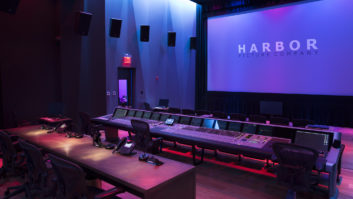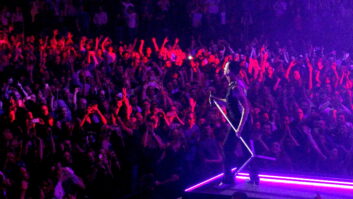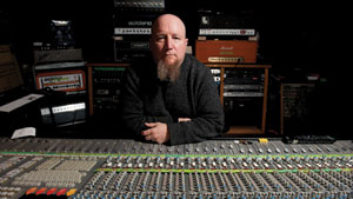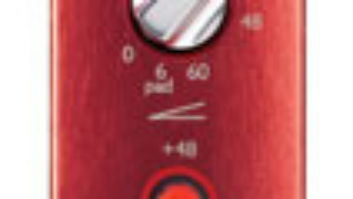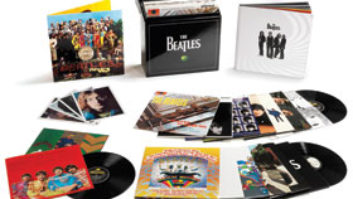I just flew in from London, and boy are my ears tired. No, not because I was packed into a five-across coach seat for six hours with 31 channels of supremely lo-fi audio. It’s because during the six days I was in England, I went to one of the loudest and most interesting concerts I’ve been to in a long, long time. And masochist that I am, I went to it twice.
Actually, I was there by invitation, as there was a piece on the program that I had something to do with. The group doing the inviting was the London Sinfonietta, probably the top avant-garde “classical” ensemble in the UK, who had joined forces for the event with electronica label Warp Records. The concerts were part of a two-week electronic music festival called Ether, which also featured shows by Tangerine Dream, Kraftwerk and legendary jazz producer/psychedelic composer David Axelrod. Opening night took place at the 2,800-seat Royal Festival Hall, which from the outside looks like an airplane hangar, but on the inside is gorgeous. It’s on the south bank of the Thames, right next to the Millennium Eye, the huge, incongruous Ferris wheel that is replacing Big Ben as a symbol of downtown London; the Tate Modern Museum, housed in a gigantic former power plant; a circular IMAX theater that can be seen for miles; and the new Salvador Dali museum in the old County Hall. Quite a neighborhood.
After the opening concert, the show hit the road, with performances in Coventry, Basingstoke, Brighton and Liverpool. The first, fourth and fifth shows were sold out, the others nearly so. Alas, I could only stick around for the first two because I couldn’t afford to take so much time away from my teaching day gig.
The concert featured music by some of the great avant-garde composers of the 20th century — John Cage, Edgar Varèse and Steve Reich — and live performances by two of today’s innovative electronic artists: Tom Jenkinson, who goes by the name Squarepusher, and Jamie Lidell. Every piece had a visual component: Squarepusher and Lidell were producing live video while they played, while the other works had films specially made for the occasion projected behind the ensemble. Presumably, these were for the benefit of those younger audience members who are not used to the idea of experiencing music without something — other than the players — to look at. They worked.
And, oh yes: They were also performing a new version of George Antheil’s 1924 Ballet Mécanique for player pianos, percussion and sound effects, which I had realized and edited to match the film of the same name, by French Dadaist Fernand Léger and American cinematographer Dudley Murphy. The two Ballet Mécaniques were originally conceived to be presented together, but because the technology to sync them didn’t exist at the time (among a lot of other problems), they never were. That’s why I was there: It was the first time this version would be performed, synched to the film, by a professional ensemble, and they wanted me to be around in case there were any problems.
Which, in fact, there weren’t. Compared to some of the other pieces on the program, Ballet Mécanique was a logistical piece of cake. Usually, the piece requires up to 16 MIDI-controlled player pianos, but to keep things simple (and because the audience’s attention would be on the film), the Sinfonietta and their intrepid electronic music and sound consultants, Sound Intermedia, arranged to play those parts on a rack of Kurzweil, Roland and Akai samplers. The film was on Betacam video, and its timecode track fed a SMPTE- (actually EBU-) to-MTC converter, which, in turn, was hooked up to a G4 PowerBook. The PowerBook ran a Digital Performer sequence that contained all of the player piano parts and triggered a Reason bank that contained the sound effects (sirens, bells and airplane propellers) and a click track for the conductor, all of which emerged from the computer via a MOTU 896 audio interface.
When I arrived in London three days before the first concert, Ian Dearden and David Sheppard, the principals at Sound Intermedia who work with many avant-garde groups in the UK and Europe, hadn’t even run the video yet. But when they got around to doing so at the next day’s rehearsal, all they needed to do was find the timecode number of the film’s first frame, line up the first beat of the sequence and — as for some reason they like to say over there — Bob’s your uncle.
The players, some of London’s top percussionists, were nothing short of astounding. David Hockings, the lead xylophonist (yes, when you have four xylophones, one of them has to be lead), asked me whether a particularly tricky scale, which had 20 notes fitting into three quick beats, could be played as a glissando — one mallet stroke sweeping across the keys — or whether they should try to play the individual notes. I told him that in all of the previous performances, the players had taken the easy way out and glissando’ed, but he just smiled and ripped off a perfect 20-note scale. And then the whole section did the same thing in unison.
Most of the time when it’s played, the Ballet Mécanique is the most complicated work on the bill, but that was not at all the case here. The stage was literally packed with hardware. Between the Antheil and other pieces on the program, an enormous array of instruments was required: four xylophones, two grand pianos and four bass drums for the Antheil; a “water gong” (a gong lowered into a bathtub), a thundersheet (an old highway sign boasting a large white-on-green arrow) and another dozen instruments for Cage’s First Construction in Metal; six marimbas for Reich’s Six Marimbas; a couple dozen instruments for an instrumental transcription of music by Aphex Twin; and some 37 noisemakers for Varèse’s Ionisation. The producers wanted there to be no long pauses between numbers, so everything in each half of the concert had to be preset. Meanwhile, each of the players’ music stands needed a light (and a fresh bulb and an extension cord) because the stage lights would be dimmed to allow the audience to see the projections; all of the players needed a clear sightline to the conductor; and every single instrument was miked for house amplification and to feed a recording crew from BBC Radio.
And I haven’t even gotten to the electronic performers’ setups, which stayed on through the whole concert. Squarepusher’s was simple: a computer tower underneath a table, with the keyboard, a glass of wine and a Victorian lamp on top. But Lidell’s rig had a laptop computer, a vintage Minimoog, an ancient Korg analog synth, a couple of scratching devices of some kind, a mixer, a couple of guitar amps and a rack of processing gear. In addition, he had an onstage video artist with him who goes by the name of Pablo Fiasco. He had his own computer and video mixer, plus a camera on a stand, another one on his shoulder and a third mounted at the end of a long elephant trunk — like pipe attached to a mutant football helmet. When Lidell put the helmet on, this “chin-cam” provided a disorienting close-up view of his constantly moving mouth.
It’s hard enough to get all this to work in one space, but taking it on the road made things exponentially more complicated. Every venue, of course, was completely different in terms of the stage’s size and shape, backstage space, lighting system, sound system, lighting and sound crews, projection systems and catering systems. In other words, it was just like a large rock ‘n’ roll tour. The plan was that the crew started loading in at each location (including the Royal Festival Hall) at 9 a.m. the day of the show, and by 2 p.m., a run-through of the London Sinfonietta’s parts of the concert was supposed to be under way. Of course, it never worked out that way; inevitably, something went wrong.
The first day, the video projector — a massive, noisy piece of gear the size of a filing cabinet — turned out to be so bright that the musicians couldn’t see anything and so had to be jacked up to get it out of their eyes. But then they found out it wasn’t bright enough for one of the films to be shown on the hall’s enormous screen, so they brought in a second one that was just as big, and spent a great deal of time lining them up so they would reinforce each other. The second day there was trouble with the video feed from Squarepusher’s onstage computer: It was making it into his monitor and into the projector, but not both at the same time. That took awhile to track down.
My time was mostly spent sitting in the dark waiting for the Ballet Mécanique rehearsals to begin and repeating to myself, “Stay calm, you have no responsibility for any of this.” And when the rehearsal finally started, I did my best to justify my presence by jumping up to tell Ian to change the balance between the samplers or bring the siren level up a little, and then I sat back to enjoy the music as best I could.
The downside to all of this, along with numerous bitten-down fingernails, was that the audience was kept out in the lobby both nights for a good half-an-hour after the halls were supposed to open. Pop audiences, who are used to being abused by promoters, take this sort of thing in stride, but it is never done at a classical music concert. But this being England, everyone was amazingly polite, despite the pressure.
All of the waiting, the work and the tension were worth it. Despite the chaos and seeming disorganization, the concerts were absolutely brilliant. Jurjen Hempel, a young conductor from Holland, masterfully guided the players through all of the pieces. The Ballet Mécanique was as gut-wrenchingly loud and energetic as I’ve ever heard it, and watching the film on the halls’ huge screens was a revelation.
Besides being the most complex, Ballet Mécanique is usually the loudest piece on any program. But again, that wasn’t true here. That honor belonged to the two electronic performers. Squarepusher’s set was largely drum ‘n’ bass with choral pads in the background — reminiscent of early Pink Floyd and a lot of what a friend referred to as “nasty HF distorted stuff” punctuating the proceedings. On record, Jenkinson’s strength is filling rhythmic spaces with unexpected, ear-catching, semi-coherent samples and synth sounds, and he used that technique for much of his performance, as well. Thankfully, he left out the obscenities he often screams at the audience. A simple but effective computer display dancing along with the music was projected on the screen. A few audience members danced, too, but most were happy to sit in their seats to groove and gape. His levels hit some near-ear-splitting peaks, and I was glad I brought my musician’s ear plugs.
Lidell’s set went much further in complexity, length and even volume. Possessing a formidable vocal instrument that evokes, at times, Bobby McFerrin, David Crosby and Otis Redding, Lidell fabricated his own rhythmic backing on the spot by looping percussive vocal sounds on top of each other into a complex bed and then harmonizing on top of that. Adding little melodic squiggles from his analog synths into the mix and pulling up other sampled sounds from his computer, he created impressively complex, dynamic riffs that never sat still, theatrically ebbing and flowing. He finally ended his breakless set by slipping into an extended R&B/gospel tune with words you couldn’t quite make out, but with unmistakable energy and enthusiasm. The guy is good, a virtuoso with his tools, both new and old, and he has a great sense of dramatic arc and timing in his improvising. He also does everything with great joy.
He was accompanied by live video that mixed industrial, architectural and abstract images with his own face from many angles, while his partner, Fiasco, dressed in a mad scientist’s lab coat, darted in and out of the spotlight. Because it was so interwoven with what Lidell was doing, the video, for a change, enhanced his performance rather than distracted from it. Best of all, on the two nights I was there, Lidell’s sets were substantially different. They combined DJ’ing, vocal improvs, looping and instrumental performance, and took them all to a very, very high level.
Obviously, it was a kick for me to be involved in a tour with such luminaries and at such prestigious venues. But these concerts meant more than that. At both shows I attended, the audience was incredibly varied: Older avant-garde fans of Cage and Reich were rubbing elbows with club-going followers of the Warp artists. One reason for this is that tickets (at least until they were sold out, which at the Royal Festival Hall happened a week before the show) were easy to buy. You could get seats at some of the concerts for as little as £10 ($18), and even the highest-priced tickets on opening night were only £22.50 ($40). Compare that to the $75 it costs to get good seats to a symphony concert in this country or the $150 or more to get within binocular range of a top-tier rock band. How is this possible? Simple: In England, the government actively promotes and subsidizes culture. Fully 40 percent of the funding for the concert series came from national and local government agencies.
Each faction of the audience had come to hear what they already knew about, but they couldn’t help but learn something, and when they left, they were aware of a whole different kind of music. The old folks (like me) could see the art, craft and virtuosity that can be part of the new electronic music, a medium we’re (okay, at least I’m) often guilty of dismissing as music to stop thinking by. This stuff made you think.
The young folks learned that modern electronica didn’t spring fully grown from the heads of Kraftwerk or Brian Eno, but that it grew out of a century of musical experimentation. Varèse was searching for, and finding, new sounds long before electronics could provide them. Cage had invented the art of industrial music, using real industrial objects. Reich could induce trances in a thousand listeners without a synthesizer or sequencer in sight. And Antheil and Léger were attempting a new kind of multisensory art form that could potentially be greater than the sum of its parts — that elusive thing called multimedia.
It’s been a long time since we in the United States have been exposed to this kind of cross-pollination on a large scale. The market-driven record and radio industries are uncomfortable with crossing boundaries and would much rather stick their music, and their audience, in easily identifiable categories. But we need more category-busting events if we are to evolve a new music that is both artful and speaks to audiences. Leonard Bernstein’s Young People’s Concerts introduced a generation to Bach, Sibelius and Stravinsky, and showed their parents the connections between classical music and jazz. The London Sinfonietta’s Ether concerts bridge the gap between yesterday’s avant-garde and tomorrow’s. More power to them — and to us.
Paul Lehrman lives in Boston, one of the few American cities where you can fly to London without seeing the sun come up.
